Resources
PQCNC 2014 Annual Meeting and Initiative Kickoff: Stephen Patrick - Neonatal Abstinence Syndrome: Scope and Evolving Issues
Get Ready Get Set Go!!
For those of you requiring IRB approval - click here
It’s officially time to get to work. The expert team has determined the needed baseline data for our work on NAS. There are 3 separate parts of baseline data that is required to move forward in the NAS initiative. We will be collecting:
- Unit Level Data
- Administration Level Data
- Patient Level Data.
Click here to view/download the baseline data collection form
Click here to download the Data Dictionary
Unit Level Data: Every team should have completed the Unit Snap Shot that details current practices related to NAS. If you have not already done so please click here and complete as soon as possible.
Administration Level Data: There are 3 pieces of administrative data that need to be collected. Please collect the following data for the time period August 2012-August 2013. Please email this data to Tammy Haithcox
- Total number of admissions or hospital births: Provides us with denominator data
- Total number of infants with ICD-9 code: 779.5. This code is for NAS that includes antenatal exposure to opiates with subsequent withdrawal syndrome requiring pharmacologic treatment. Numerator data for percentage of opiate-exposed infants care for within you facility
- Total number of infants with ICD-9 code: 760.72. This code is for opiate-exposure without the criteria of postnatal treatment for NAS. Numerator data for percentage of infants who are exposed to opiates cared for within your facility.
Patient Level Data: This data will be entered into Delphi, the database for all initiatives. (Data Collectors: Please click here for instructions of how to obtain access to Delphi to submit data.)
- Each facility will complete the PQCNC NAS Data Collection Sheet on the last 10 patients they have scored for NAS. We may not be able to get all of the questions answered retrospectively but will ask that you complete as much as possible.
- Please indicate for these ten patients whether parents were in a drug treatment program or if they were referred to one during their hospital stay.
Outstanding Prerequisites: If your team has not completed the following please do so before Jan 7th.
- Unit Snap Shot
- At least one team member needs to complete PQIT-UP QI training modules
- Complete Roster
- Family/Pt member on your team or have contacted Tara Bristol to develop plan to include.
- Register for and attend the NAS Kick-off meeting
Instructions for Prework
The pre-work literature provides background and research on current practices in the areas of Identification, Evaluation, Treatment and Discharge of the infant with NAS. Please review the General and Treatment information; everyone will be working in these areas together at the action-planning meeting. Each expert team member will need to also review the information related to the breakout session you have chosen to be a part of.
NAS General: The following articles are from national Groups and organizations as well as background articles.
Neonatal Drug Withdrawal: AAP’s statement on neonatal drug withdrawal. This statement updates information about the clinical presentation of infants exposed to intrauterine drugs and the therapeutic options for treatment of withdrawal and is expanded to include evidence-based approaches to the management of the hospitalized infant who requires weaning from analgesics or sedatives.
Opiate treatment for opiate withdrawal in newborn infants (Review): Cochran review of current literature assessing effectiveness and safety of using opiates for withdrawal in infants.
Neonatal Abstinence Syndrome Clinical Practice Guidelines: Practice guidelines created by the Provincial Council for Maternal Child Health in Ontario
Prenatal Substance Abuse Short- and Long-term Effects on the Exposed Fetus: AAP Committee on Substance Abuse and Committee on Fetus and Newborn report on the most common drugs involved in prenatal exposure, addresses primary care pediatrician’s role in prenatal exposure includes prevention, identification of exposure, recognition of medical issues, protection of the infant and follow-up of the exposed infant.
Neonatal abstinence syndrome: A review that discusses the complex nature of maternal and other factors that can affect the infant’s display of neonatal abstinence syndrome (NAS), clinical presentation and treatment of NAS, and the impact of recent findings on future directions for research.
NICU Nurses’ Lived Experience: primary aim of this qualitative methods study was to describe the lived experiences of neonatal intensive care unit (NICU) nurses with ethical and morally challenging issues.
NAS Management Algorithm Treat or not to Treat: Example algorithm for determining whether to treat the infant
NAS Management Algorithm Stabilization on Morphine: Example algorithm for maintaining or increasing dose of morphine
NAS Management Algorithm Weaning: Example algorithm for weaning morphine
NAS Management Algorithm Backsliding: Example algorithm for infants that have difficulties with weaning
PQCNC NAS Swimlane: High-level process map indicating the steps in the identification, evaluation, treatment, and discharge of a patient. Pages 1-4 look at the individual process of each area. Page 5 shows the entire process
NAS Identification: The following articles are related to methods for identification of exposure
Perinatal Effects of Combined Use of Heroin, Methadone, and Amphetamine during Pregnancy and Quantitative Measurement of Metabolites in Hair: There has been very limited research on the clinical features of newborns exposed to combined use of heroin, methadone, and amphetamine in the uterus. This study describes a technique for the quantification of drug metabolites in neonatal hair samples
Opioid Detection in Maternal and Neonatal Hair and Meconium: Characterization of an At-Risk Population and Implications to Fetal Toxicology: Identification of maternal opioid abuse in pregnancy is often difficult to ascertain in the absence of a reliable self-report. This study aimed to characterize an at-risk neonatal population for opioid exposures as well as other drugs of abuse and alcohol
Identification and Management of Neonatal Abstinence Syndrome: This article focuses on drug abuse during pregnancy, the withdrawal symptoms it may cause in the infant, ways to recognize an infant experiencing neonatal abstinence syndrome, and available scoring tools and treatment options.
Identifying Infants at Risk for Neonatal Abstinence Syndrome: The main objective of this study was to analyze the consistency in using a standardized newborn toxicology screening protocol to identify infants at risk of developing neonatal abstinence syndrome
Drugs of abuse testing in meconium: In spite of increased sample preparation time relative to blood and urine, the long metabolic history, coupled with the ease and wide window of collection of meconium make it the ideal matrix for determining fetal drug exposure.
Comparison of meconium and neonatal hair analysis for detection of gestational exposure to drugs of abuse: In cases of clinical suspicion and a negative neonatal urine test, both meconium and hair are effective biological markers of in utero illicit drug exposure. Meconium may be more sensitive, but neonatal hair is available for three months whereas meconium is available for only one or two days.
Neo Methods for Neonatal Drug Screening: Article that describes perinatal and neonatal complications of maternal use of cocaine, alcohol, opiates, and barbiturates in pregnancy. Provides established cutoffs of conventional immunoassays of urine for common substances of abuse. List the advantages of using meconium testing for substances of abuse. Describes the role of fatty acid ethyl esters in detecting prenatal alcohol exposure.
Prenatal Substance Exposure: Maternal Screening and Neonatal Identification and Management: Article that describes physical and neurobehavioral problems of neonates who were exposed to maternal substances of abuse. Delineates the purpose of universal screening. Characterizes the areas of inquiry represented by the 4P’s Plus assessment. Describes the significant features of neonatal abstinence syndrome. Delineates supportive measures for management of infants exposed prenatally to substances of abuse
Effectiveness of a targeted screening program in identifying infants with positive urine toxicology screening results in a regular neonatal nursery: Study that compared the effectiveness in identifying infants with positive results on urine screening for drugs of abuse of a universal screening program and a targeted screening program on the basis of clinical suspicion.
Identifying Infants at Risk for Neonatal Abstinence Syndrome: Main objective of this study was to analyze the consistency in using a standardized newborn toxicology screening protocol to identify at risk of developing NAS
Testing for fetal exposure to illicit drugs using umbilical cord tissue vs meconium: Study with the objective of assessing the agreement of testing for exposure contrasting specimens of meconium vs umbilical cord tissue. Umbilical cord tissue performs as well as meconium in assessing fetal drug exposure to amphetamines, opiates, cocaine, and cannabinoids. Results of studies using the cord may have a more rapid return to the clinician.
NAS Evaluation: The following articles are related to methods to evaluate for NAS
The Opioid Exposed Newborn: Assessment and Pharmacologic Management: Review from the NIH to provide health care professionals with current evidence and practical guidelines for optimal evaluation and pharmacologic management of opioid exposed newborns.
Finnegan neonatal abstinence scoring system: normal values for the first 3 days and weeks 5-6 in non-addicted infants: The purpose of this study was to assess the variability of the scores in newborns and infants not exposed to opiates during the first 3 days of life and during 3 consecutive days in weeks 5 or 6.
Establishment of Inter-observer Reliability Using the Finnegan Neonatal Abstinence Scoring Tool: Presentation that discusses the importance of attaining reliability with clinical screening tools and helping to determine inter-observer reliability
Management of neonatal abstinence syndrome in neonatal intensive care units: a national survey: Aim of the study was to determine the monitoring and treatment of NAS in NICU’s following opiate or polydrug exposure in utero
Implementing Practice Guidelines and Education to Improve Care of Infants With Neonatal Abstinence Syndrome: Purpose was to develop and implement a program for the management of NAS and the use of the Finnegan tool.
NAS Treatment: The following articles are related to treatment of NAS
Clonidine as an Adjunct Therapy to Opioids for Neonatal Abstinence Syndrome: A Randomized Controlled Trial: Objective of the study was to determine if oral clonidine would reduce the duration of opioid detoxification for neonatal abstinence syndrome.
ABM Clinical Protocol #21: Guidelines for Breastfeeding and the Drug-Dependent Woman: Purpose of this protocol is to provide evidence-based guidelines for the evaluation and management of the drug-dependent woman choosing to breastfeed
Methadone Maintenance and Breastfeeding in the Neonatal Period: This study-evaluated concentrations of methadone in breast milk among breastfeeding women and concentrations of methadone in maternal and infant plasma in both groups. Results contribute to the recommendation of breastfeeding for methadone-maintained women
Effects of Breast Milk on the Severity and Outcome of Neonatal Abstinence Syndrome Among Infants of Drug-Dependent Mothers: The purpose of this research was to assess the effects of breast milk on the severity and outcome of neonatal abstinence syndrome.
Buprenorphine: A Newer Drug for Treating Neonatal Abstinence Syndrome: Article reviews current literature on Buprenorphine and use in NAS
Comparison of chlorpromazine versus morphine hydrochloride for treatment of neonatal abstinence syndrome: Aim of study was to compare the duration of treatment for neonatal abstinence syndrome (NAS) using chlorpromazine versus morphine hydrochloride. Conclusion: CP appears to shorten the duration of NAS compared with MH. Larger prospective randomized trials are needed to confirm our findings.
Use of clonidine in the prevention and management of neonatal abstinence syndrome: Presentation of case series in which clonidine was used for the prevention and management of patients with NAS. Data suggest that clonidine may be a reasonable alternative to more traditional agents used to prevent or treat NAS.
Diluted tincture of opium (DTO) and phenobarbital versus DTO alone for neonatal opiate withdrawal in term infants: The purpose of this study was to test the hypothesis that treatment of neonatal opiate withdrawal (NOW) in the term infant with diluted tincture of opium (DTO) and phenobarbital was superior to treatment with DTO alone.
Identification and Management of Neonatal Abstinence Syndrome: This article focuses on drug abuse during pregnancy, the withdrawal symptoms it may cause in the infant, ways to recognize an infant experiencing neonatal abstinence syndrome, and available scoring tools and treatment options.
A Retrospective Study of Length of Hospital Stay in Infants Treated for Neonatal Abstinence Syndrome With Methadone Versus Oral Morphine Preparations: Purpose of study: Length of hospital stay (LOS) of infants treated for neonatal abstinence syndrome (NAS) with methadone was compared to LOS of those treated with an oral morphine preparation (OMP, neonatal morphine solution, or deodorized tincture of opium).
The Opioid Exposed Newborn: Assessment and Pharmacologic Management: Review from the NIH to provide health care professionals with current evidence and practical guidelines for optimal evaluation and pharmacologic management of opioid exposed newborns.
Maternal and neonatal factors impacting response to methadone therapy in infants treated for neonatal abstinence syndrome: Objective of study was To identify maternal and neonatal factors that impact response to methadone therapy for neonatal abstinence syndrome.
Neonatal Abstinence Syndrome: Therapeutic Interventions: This article provides an overview of the possible risks, benefits, and outcomes of pharmacologic and complementary therapies in the neonatal population, and illustrates the gaps in knowledge related to their use for neonatal withdrawal.
The Opioid Dependent Mother and Newborn Dyad: Nonpharmacologic Care: The purpose of this article is to review the contribution of maternal opioid dependency to the difficulties experienced by the mother-infant dyad and their treatment providers in the postnatal period, and the nonpharmacologic treatment of the infants with suggestions for practical measures with emphasis on the treatment of the mother and baby as an interactional dyad.
Update on the pharmacologic management of neonatal abstinence syndrome: This review addresses risk factors and pathophysiology of NAS, summarizes parameters of common drugs used for the management of NAS, and reviews published literature of standard therapies as well as newer agents.
Differences in the profile of neonatal abstinence syndrome signs in methadone-versus buprenorphine-exposed neonates: Aim was to compare the profile of signs of neonatal abstinence syndrome (NAS) in methadone- versus buprenorphine-exposed infants.
Management of neonatal abstinence syndrome: a national survey and review of practice: Aim was To ascertain the present management of neonatal abstinence syndrome (NAS) in neonatal units in the United Kingdom (UK) and Ireland
Rooming-in compared with standard care for newborns of mothers using methadone or heroin: Objective was to evaluate the effect of rooming-in (rather than standard nursery care) on the incidence and severity of neonatal abstinence syndrome among opioid-exposed newborns and on the proportion of mothers who retain custody of their babies at hospital discharge.
NAS Discharge: The following articles are related to discharge concerns for NAS patients
Hospital stay and short-term follow-up of children of drug-abusing mothers born in a urban community hospital: Review of current NAS practices in regard to short term outcomes. New ways to ensure better coordination of care should be developed.
Opioid Dependency in Pregnancy and Length of Stay for NAS: Objective of the study was to examine opioid replacement therapy in pregnancy and effect on neonatal outcomes, including LOS for NAS.
Neonatal abstinence syndrome: transitioning methadone-treated infants from an inpatient to an outpatient setting: The objective of this study is to compare the safety and efficacy of a traditional inpatient only approach with a combined inpatient and outpatient methadone treatment program
A pilot study assessing the frequency and complexity of methadone tapers for opioid abstinence syndrome in children discharged to home: The objective of this study was to determine the percentage of children discharged home on methadone tapers and to develop, assess, and implement an instrument for measuring the complexity of the methadone regimens.
NAS Outcome Measures:
The overall aims statement for the NAS initiative was developed by the expert team along with outcome measures to ensure a standardized approach to the care of the NAS infant and family.
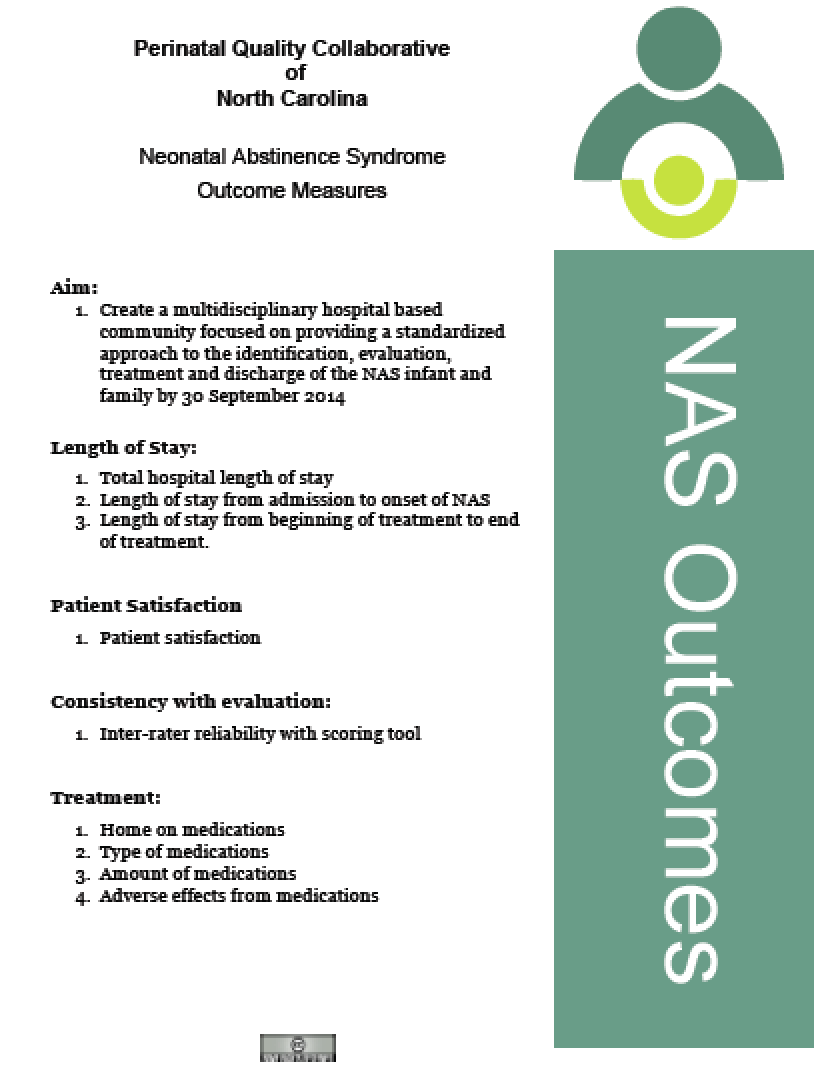
Examples of NAS Management Algorithms
The expert team is using the following examples to create Care Management Algorithms to standardize the treatment of NAS:
Phase I: To Treat of not to treat algorithm is used to determine whether the patient will be treated with non-pharmacologic methods or whether they will receive pharmacologic treatment
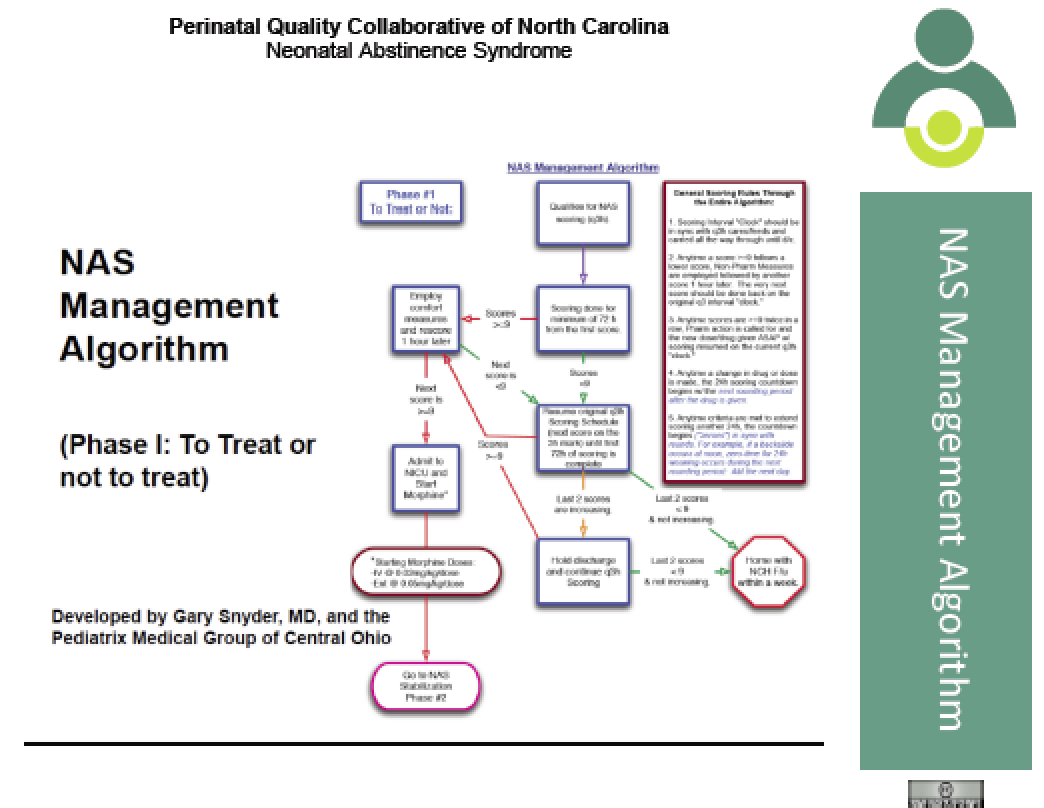
Phase II: Stabilization on Morphine algorithm is used to begin treatment and to increase dosing if needed.
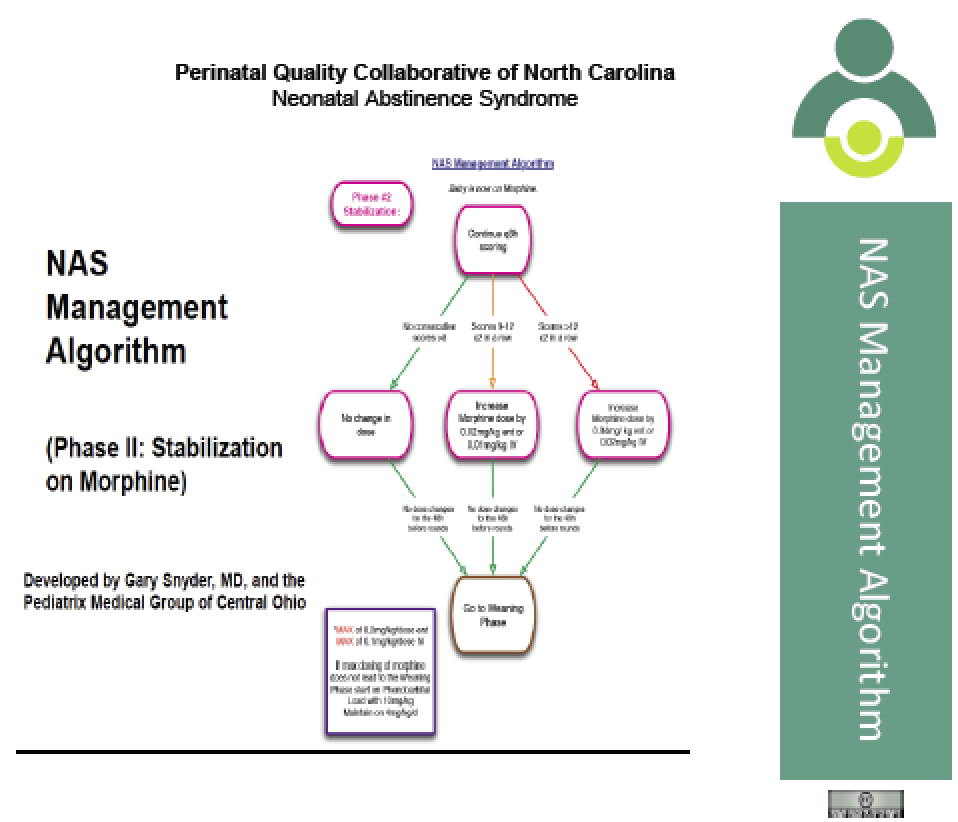
Phase II Stabilization algorith
Phase III: Weaning
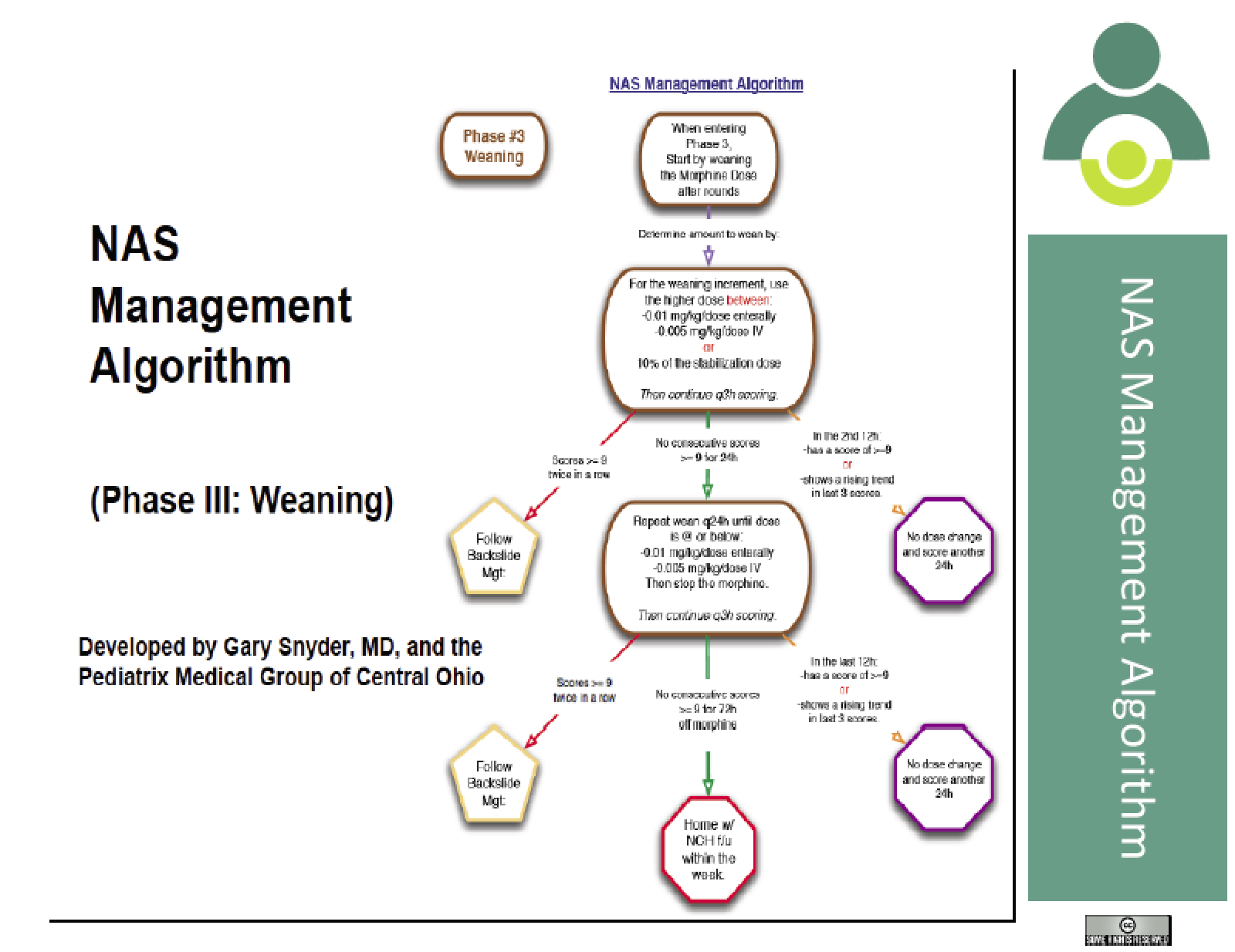
Phase III Backsliding
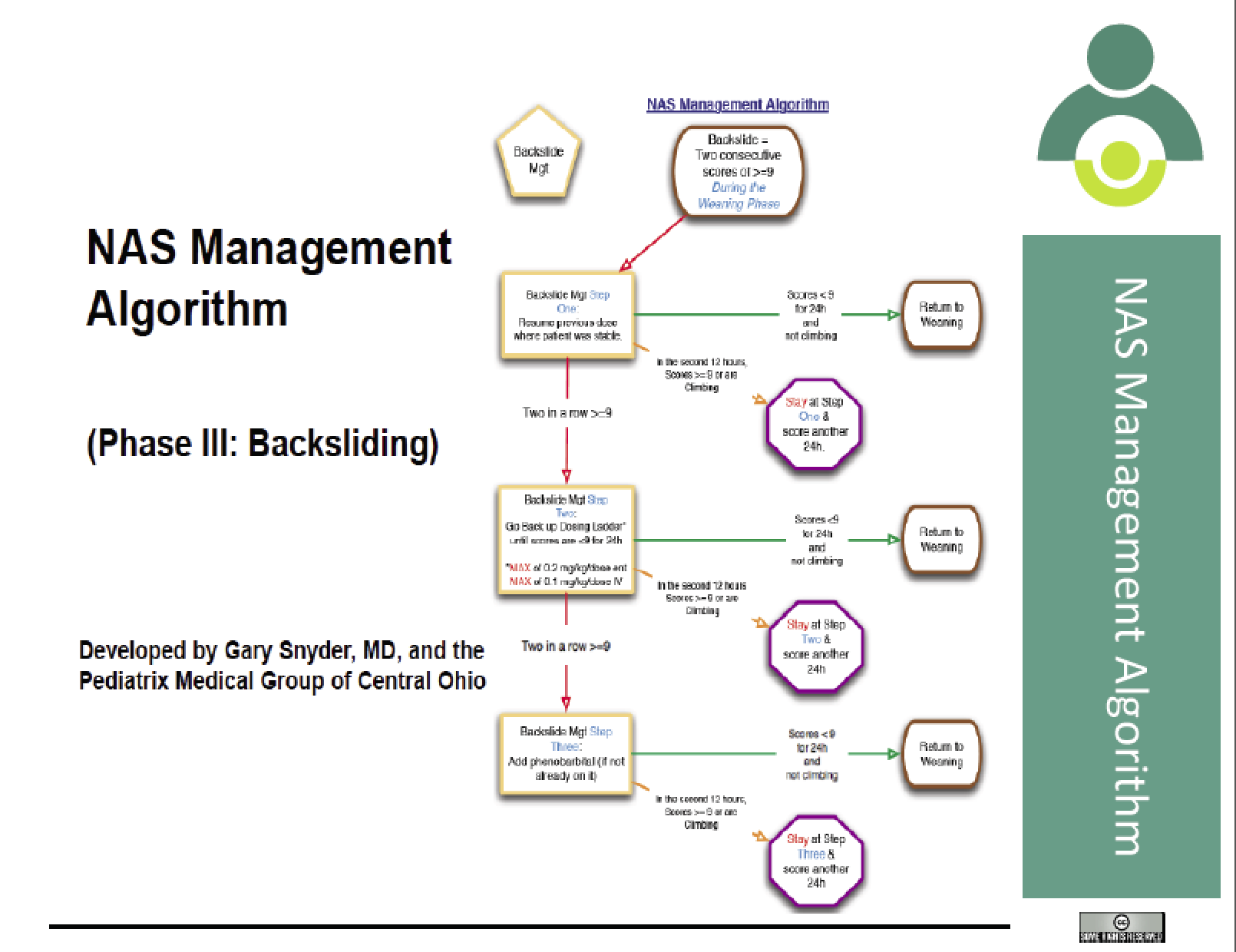
Phase III Backsliding algorithm
Carolinas Healthcare System: Management of Pain in the Neonate
Guidelines to ensure the assessment and management of neonatal pain and potential opioid withdrawal
Catawba Valley Medical Center: Drug Withdrawal
Guidelines on care needed by infants of mothers that used methadone/opiates or other substances while pregnant.
Forsyth Medical Center: Neonatal Abstinence Management
Guidelines for the management and cohorting of infants experiencing withdrawal symptoms.
Forsyth Medical Center: Best Practice Neonatal Abstinence Syndrome
Collection of best practices for the treatment of NAS - part 1
Forsyth Medical Center: Neonatal Abstinence Assessment
Collection of best practices for the treatment of NAS - part 2
UNC: Urine Toxicology Screening on Labor and Delivery Clinical Guidelines
Guidelines of who should be screened and a description of toxicology testing available at UNC
UNC: UNC Newborn Nursery Clinical Guidelines
Guidelines for the treatment of Neonatal Abstinence Syndrome
Brochure for parents on what to expect with NAS
Vidant: NAS Policy and Procedure
Policy for assessment and care of NAS infant
Vidant: Procedure for management of NAS using Clonidine with Morphine
Details the dosing for pharmacologic treatment of NAS
Vidant: Guide to NAS - What to expect for your baby
Parent education booklet
Presby: NAS Initiation
Initiation order set for NAS
Presby: NAS Symptom-Based Protocol
Protocol for symptom-based morphine administration
Missed the NAS Expert Team 'Data' Conference Call? Listen here...
